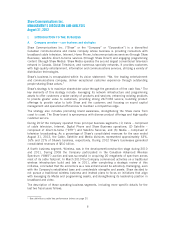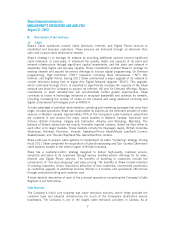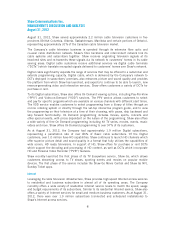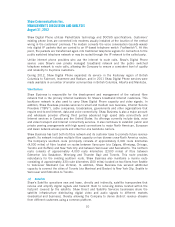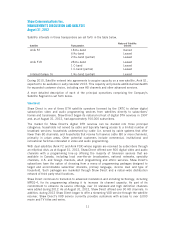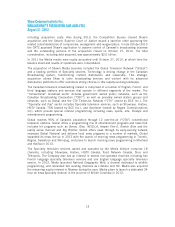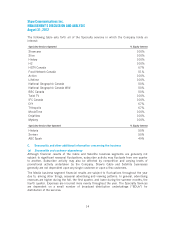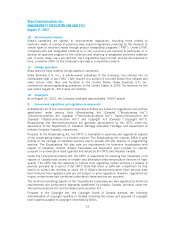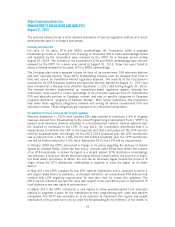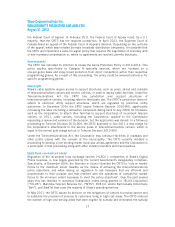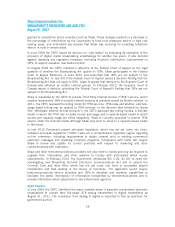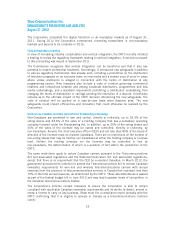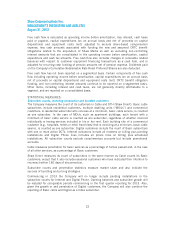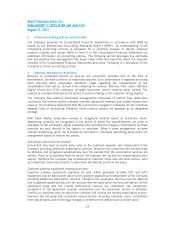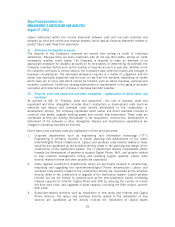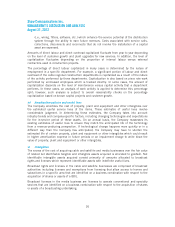Shaw 2012 Annual Report Download - page 20
Download and view the complete annual report
Please find page 20 of the 2012 Shaw annual report below. You can navigate through the pages in the report by either clicking on the pages listed below, or by using the keyword search tool below to find specific information within the annual report.Shaw Communications Inc.
MANAGEMENT’S DISCUSSION AND ANALYSIS
August 31, 2012
The sections below include a more detailed discussion of various regulatory matters and recent
developments specific to Shaw’s businesses.
Licensing and ownership
For each of its cable, DTH and SRDU undertakings, the Corporation holds a separate
broadcasting license or is exempt from licensing. In November 2010, cable undertakings owned
and operated by the Corporation were renewed by the CRTC for a five-year period ending
August 31, 2015. The licenses of the Corporation’s DTH and SRDU undertakings were recently
renewed by the CRTC for a seven year period to August 31, 2019. Shaw has never failed to
obtain a license renewal for its cable, DTH or SRDU undertakings.
The Company also holds a separate license for each of its conventional OTA television stations
and each specialty service. These CRTC broadcasting licenses must be renewed from time to
time and cannot be transferred without regulatory approval. The majority of the Corporation’s
licenses for its OTA television stations and specialty services expired on August 31, 2011 and
were renewed for a five-year term effective September 1, 2011 and ending August 31, 2016.
The renewal decision implemented an expenditure-based regulatory regime, whereby the
Corporation must expend a certain percentage of its prior-year revenues from its conventional
OTA and specialty services on Canadian content, and also on specific categories of Canadian
programs defined as “programs of national interest”. With certain restrictions, the Corporation
may share these regulatory obligations between and among its various conventional OTA and
specialty licenses. These obligations are imposed on an individual license basis.
The potential for new or increased fees through regulation
Effective September 1, 2009, each licensed BDU was required to contribute 1.5% of its gross
revenues derived from Broadcasting to the Local Programming Improvement Fund (“LPIF”) to
support local television stations operating in non-metropolitan markets. Exempt systems were
not required to contribute to the LPIF. In July 2012, the Commission determined that it is
inappropriate to maintain the LPIF in the long term and that it will phase out the LPIF over the
next two broadcast years. Accordingly, for the 2012-2013 broadcast year, the LPIF contribution
rate is reduced from 1.5% to 1.0%. For the 2013-2014 broadcast year, the LPIF contribution
rate will be further reduced to 0.5%. As of September 2014, the LPIF will be discontinued.
In October 2008 the CRTC announced a change in its policy regarding the delivery of distant
signals by licensed BDUs. Under the new policy, licensed cable BDUs must obtain the consent
of an OTA broadcaster to deliver its signal in a distant market. DTH distribution undertakings
can distribute a local over-the-air television signal without consent within the province of origin,
but must obtain permission to deliver the over-the-air television signal beyond the province of
origin unless the DTH distribution undertaking is required to carry the signal on its basic
service.
In May 2011 the CRTC released its new DTH satellite distribution policy, pursuant to which it
will require Shaw Direct to distribute, in standard definition, all conventional OTA stations that
conform with LPIF eligibility requirements 30 days after Anik G1 comes into operation. The
CRTC did not introduce any specific rules with respect to the permitted scope of distribution of
local stations or any new rights of remuneration.
In March 2010 the CRTC introduced a new regime to allow privately-owned local television
stations to negotiate a value for the distribution of their programming with cable and satellite
companies. The CRTC was uncertain as to its authority to implement this regime and sought
clarification of its jurisdiction to do so under the Broadcasting Act by reference of the matter to
16


